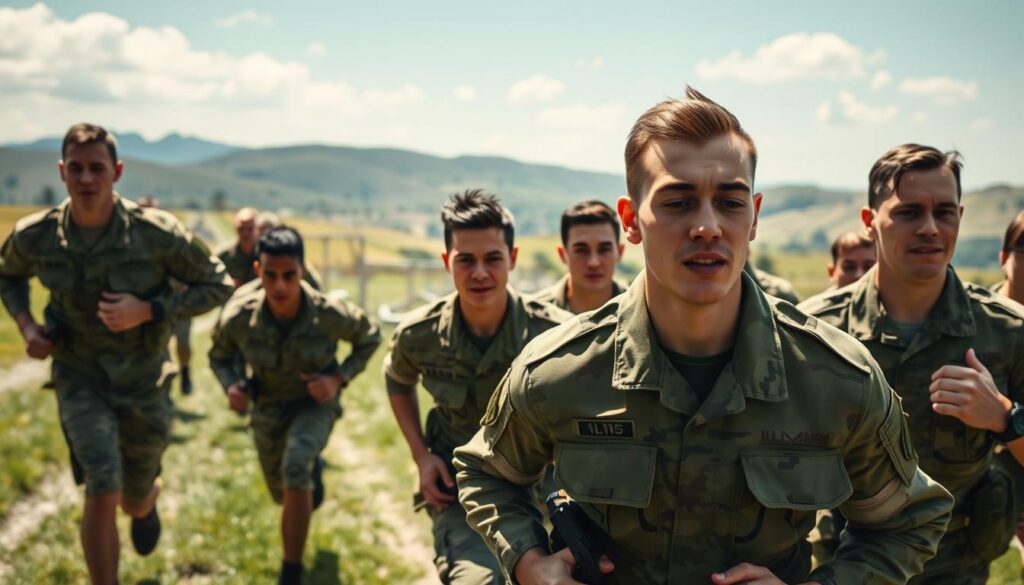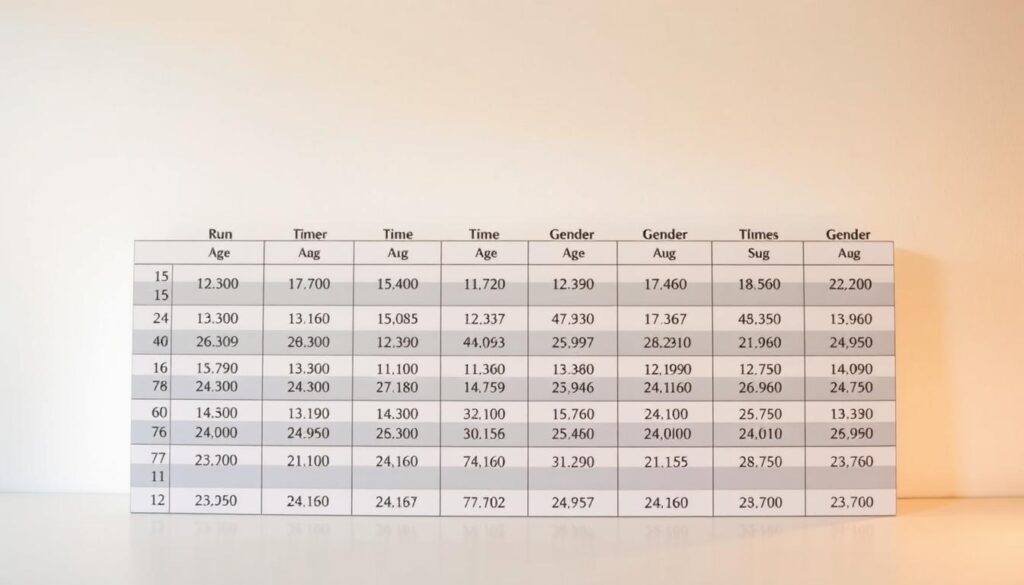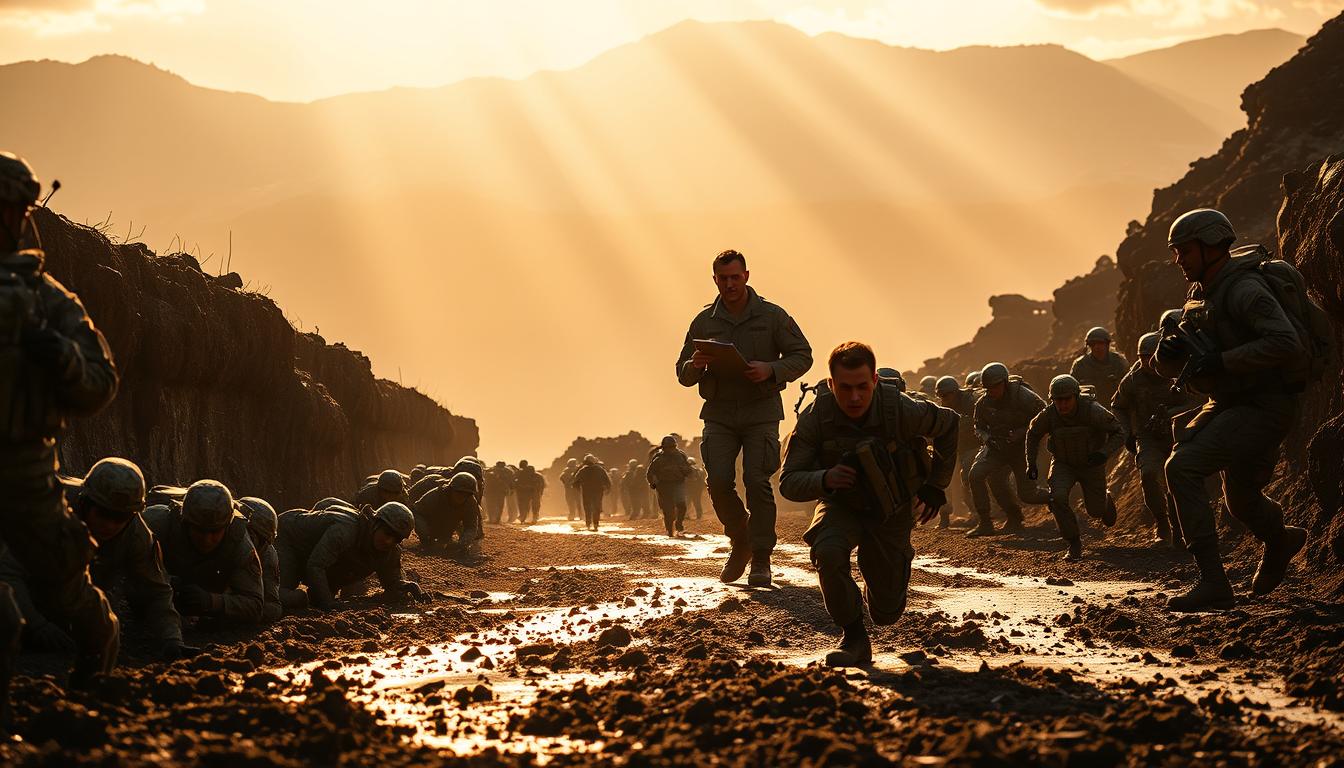Physical fitness is key in military service. Every soldier must meet the military fitness requirements.
But what are these requirements, and how do you meet them? The physical fitness test standards change with age and gender. This makes it tough for some to get ready.
Knowing the Army’s physical fitness expectations is crucial for success. This article will give you an overview of the current standards. It will also help you improve your performance.
Key Takeaways
- Understand the varying physical fitness requirements for different age groups and genders.
- Learn how to prepare for the physical fitness test to meet the required standards.
- Get tips on improving your overall physical fitness to excel in the military.
- Discover the importance of physical fitness in military service.
- Find out how to tailor your training to meet the specific requirements.
Overview of Army Run Time Standards
The Army Run Time Standards are key to measuring a soldier’s fitness. They are part of the Army Physical Fitness Test (APFT). This test checks if a soldier can do their job well.
Being fit is vital in the military. It affects how well a soldier can do their job. The Army Run tests a soldier’s endurance and agility. These are important for being fit.
Importance of Physical Fitness in the Military
Being fit is essential for military readiness. Soldiers need to stay in shape to do their jobs safely and well. The Army Run is a big part of this. It checks how fast a soldier can run a certain distance.
- Boosts endurance and stamina
- Better physical performance
- Less chance of getting hurt during training and missions
Objectives of Army Run Tests
The main goal of the Army Run test is to see how well a soldier can run. It makes sure soldiers stay fit for their jobs.
- To see if a soldier can run a set distance in time
- To check a soldier’s heart health
- To find out where a soldier needs to get better at fitness
Knowing the Army Run Time Standards helps soldiers get ready for military life. The army PT test guidelines help soldiers meet the soldier fitness benchmarks. This ensures they can always do their jobs.
Current Army Run Requirements
The Army’s run requirements are key to a soldier’s fitness. They check how well a soldier can run and handle different situations.
Age and Gender Categories
The Army sorts soldiers by age and gender for run tests. There are age ranges like 17-21, 22-26, and so on, up to 60 and older. Each range has specific run times for men and women.
Standard Run Distances
The Army’s main run test is 2 miles. But, the Army Combat Fitness Test (ACFT) also includes a 2-mile run. It looks at more than just running.
| Age Group | Male Run Time | Female Run Time |
|---|---|---|
| 17-21 | 13:30 | 15:30 |
| 22-26 | 14:00 | 16:00 |
| 27-31 | 14:30 | 16:30 |
| 32-36 | 15:00 | 17:00 |
| 37-41 | 15:30 | 17:30 |

The table shows the run time standards for men and women in different age groups. Knowing these standards helps soldiers prepare for the run test.
Scoring the Army Run
Knowing how the Army run is scored is key for soldiers to prepare well. The scoring system checks a soldier’s endurance and performance by their run time.
Time Standards Explained
The Army run time standards are the marks against which soldiers’ performances are judged. These standards change with age and gender, making sure the test is fair. It accounts for physical differences among soldiers.
These time standards aim to challenge soldiers but also measure their fitness level. Younger soldiers are expected to do better than older ones. This is because physical abilities naturally decline with age.
Grading System Overview
The Army run grading system is simple: soldiers get points based on their run time. The more points, the better the performance. These points help figure out a soldier’s fitness score.
| Age Group | Gender | Minimum Time | Maximum Points |
|---|---|---|---|
| 17-21 | Male | 13:30 | 100 |
| 17-21 | Female | 16:30 | 100 |
| 22-26 | Male | 14:00 | 100 |
| 22-26 | Female | 17:00 | 100 |
The table shows the minimum time needed for the max points in different age groups and genders. Soldiers who finish faster get the max points. Those who take longer get fewer points.
Improving scores needs regular training and a good plan. Soldiers should work on their endurance. This will help them get better times and higher scores.
Differences by Age and Gender
The Army’s fitness standards change with age and gender. This is because men and women, and younger and older soldiers, have different physical abilities. The Army takes these differences into account.

Time Adjustments for Age Groups
The Army’s run times adjust with age. Older soldiers get more time to finish the run. This makes fitness tests fair for all ages.
Here are some key points about time adjustments:
- Younger soldiers (17-21 years) face stricter run time standards.
- Soldiers aged 22-26 have slightly more lenient standards.
- As soldiers get older (27-31 and beyond), the standards adjust, giving them more time.
Special Considerations for Female Soldiers
Female soldiers have their own run time standards. This is because men and women are physically different. For more on this, visit this resource.
The Army’s standards for women are fair and realistic. They reflect the average physical differences between men and women. This includes:
- Adjusted run times that are longer than those for male soldiers in the same age category.
- Recognition of the different physical capabilities and fitness levels between genders.
By having these standards, the Army ensures fairness for all soldiers, no matter their age or gender.
Preparing for the Army Run
To get ready for the Army run, you need a solid plan. This plan should cover both physical training and what you eat. Building up your endurance and stamina is key. You’ll need to stick to a training schedule.
Training Regimens and Recommendations
A good training program is vital for the Army run. It should include cardio, strength training, and stretching. Run at least three times a week, with a longer run on the weekends.
Sample Training Regimen:
- Monday: 30-minute easy run
- Wednesday: Interval training (e.g., 4x800m at a fast pace)
- Friday: 30-minute easy run
- Sunday: Longer run (60-90 minutes)
Adding strength training, like squats and lunges, can boost your running. It also helps prevent injuries.
Nutrition Tips for Optimal Performance
Good nutrition is crucial for the Army run. Eat a balanced diet with carbs, proteins, and fats.
Key Nutritional Tips:
- Drink lots of water all day
- Eat complex carbs like whole grains and fruits for energy
- Choose lean proteins like chicken and fish for muscle repair
- Avoid big meals before running; go for light snacks instead
With the right training and nutrition, you can do great in the Army run. This will help you meet the army physical training standards.
Common Mistakes to Avoid
When getting ready for the Army run, knowing common mistakes is key. These errors can slow you down. By avoiding them, you can improve your Army run time standards.
Misjudging Personal Pace
One big mistake is not knowing your own pace. Some start too fast and get tired, while others start slow and don’t catch up. It’s important to practice pacing during your training.
- Start with a conservative pace to warm up.
- Adjust your speed based on your performance during training runs.
- Practice running at different intensities to build endurance.
Inadequate Training Preparation
Not training enough is another common error. This includes not running enough and ignoring strength and flexibility exercises. A balanced training program is key to meet the physical fitness test standards.
To get better, mix up your training. Try interval training, hill sprints, and long runs. Also, eat right to support your training and recovery.
Resources for Army Run Training
Getting ready for the Army Run means using the best tools to boost your performance. Soldiers can find many resources to help them run faster and stay fit.
Official Army Websites and Materials
The Army’s official website has all the Army PT test guidelines you need. It explains how to pass the run test, including scoring and training tips.
There are also soldier fitness benchmarks for every age and gender. These benchmarks help set realistic goals for your training.
Local Fitness Programs and Clubs
Local fitness programs and clubs are also key for army run performance metrics. They offer special training for soldiers getting ready for the Army Run.
These programs include coaching, group runs, and customized training plans. They help soldiers reach their running and fitness goals.
Using both Army resources and local programs gives soldiers a strong support system. This helps them do well in the Army Run.
FAQs About Army Run Standards
Knowing the Army run standards is key for soldiers to meet fitness needs. We answer some common questions to clear up army physical training standards.
Consequences of Not Meeting the Standards
If a soldier doesn’t meet Army run standards, they might face extra training or actions. It’s vital for soldiers to know the fitness goals for army personnel to avoid these issues.
Retaking the Test
Soldiers who don’t meet standards can try again after more training. This chance helps them get better and meet the army’s physical standards.
Understanding Army run standards and the consequences helps soldiers prepare better. It shows how important regular training and following military fitness rules are.


